Intelligent Creatures is a Canadian effects house, part of the Candian Cartel. The company was formed by artists Raymond Gieringer, Michael Hatton, Lon Molnar and Wendy Lanning. We caught up with some of the founders to talk about some of their work on films such as Babel, Stranger Than Fiction and The Fountain.
Intelligent Creatures was formed by artists Raymond Gieringer, Michael Hatton, Lon Molnar and Wendy Lanning. The co-founders of Intelligent Creatures met while working in the visual effects industry in Toronto, Ontario Canada. Each came from separate but matching senior positions, covering all aspects of visual effects production — from VFX Supervisor to Compositor, Animator and Producer. Opening in 2003, the company has had great success with projects such as Babel, Stranger than Fiction and Mr and Mrs Smith.
We caught up with a few of the principles recently and discussed their latest films
Lon Molnar on Babel
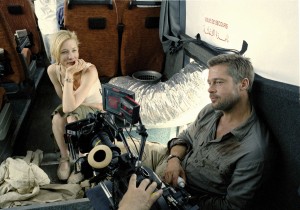 To quote Paul Byrnes of the Sydney Morning Herald:
To quote Paul Byrnes of the Sydney Morning Herald:
“The story of the Tower of Babel turns up in Hebrew and Muslim texts, as well as the Bible, but the basic gist is that men tried to build a stairway to heaven and God subverted them by giving them different languages. They could no longer understand each other, so the whole construction fell apart.”
It’s a powerful myth because it carries so many ideas: that there are two worlds and we got the lesser one; that God is spiteful; that cultural differences are the root of all our woes since then; even that crossing a border without permission will get you in a whole world of trouble.
The story of the tower works so well for what the film is about, which is that the relationship between rich and poor, as individuals or countries, is much more connected than we might think. It’s a film about the terrible consequences of bad decisions.
fxg: When did you first get involved in the project?
LM: We received a call from Ann Ruark, line producer on the project in the early summer of ’05. After discussions with both Ann and producer Jon Kilik, we understood the level of realism Alejandro was after and winded up being a good fit for the project. Given that there was an extensive international cast and crew, adding a Canadian contingent seemed a natural choice.
fxg: How many shots did you end up doing ?
LM: We did 27 shots in total, mostly subtle elements in order to further support the story. From minor recomposition of shots to removing the head of a chicken, and enhancements to a key sequence in the film – an interactive bullet hit and several blood flow elements. Our biggest shot was the final shot in the film – a helicopter pullback through a digital Tokyo.
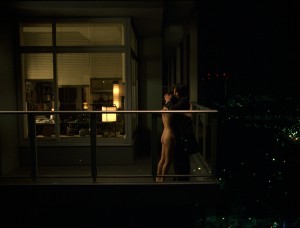
fxg: For the Chieko’s apartment shot – can you explain how you solved some of the issues in that pull out shot?
LM: One of the major issues for the shot was logistics in Tokyo. It wasn’t simple to have anything happen there, which led to guerrilla style approach. The simplest approach to the shot, and one that wasn’t going to interrupt flow with the Director, was to shoot the plate on location, with very little interference from VFX. The camera was fit to a Libra Head, which was mounted to the end of a camera crane, running along a track on the roof of a 30 storey building. The camera hung over the roof to shoot the plate of Koji Yakusho (Yasujiro) and Rinko Kikuchi (Chieko).
We began the shot, pulled back about 30 feet, locked the camera down and kept rolling, allowing us the footage to digitally continue the shot via digital extension. Next up was to tile the main building via another vantage point, matching the camera line set during the shoot. We scouted a location nearby, inconspicously entering another building to shoot hirez tiled plates, and 35mm film reference. We also shot several footage of Tokyo from the main rooftop with 35mm film in order to get as much moving reference as to build up matte painting elements, and real moving elements to project in 3D.
Surrounded by the city at 30 stories high for nights allowed me to really analyze the true essence of Tokyo, and what elements were most important to help sell the shot. I studied the importance of reflections and how much of a presence they had at that height, knowing they would be a priority when trying to sell the shot.
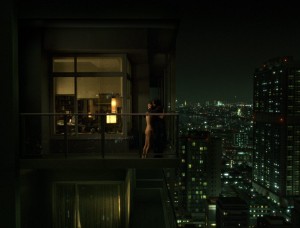
Back at IC in Toronto, we began modeling recognizable landmarks, and various hero buildings, as well as misc. buildings. Our lead modeler had a background in Architecture, which assisted in not only modelling buildings in with accuracy, yet also constructing city blocks which looked and felt natural. The transition from real camera to CG pickup was quite the challenge as the camera speed needed to feel consistant without being noticeable at the point of handoff. This was resolved by bringing the live action plate completely into the digital realm, tracking the intro, taking this track information, and combining it to the backend digital camera, then we would finesse and smooth the connection.
The actors were roto’d in order to give us complete control over all composition for city of Tokyo. Several Camera Projections were created, as well as separate projections for windows, giving us further control over window reflections, glows, etc.
Close attention was given to details such as air and ground traffic, ground level lights or “pin light passes” were created to help reveal and hide streetlights as needed in order to support parallax. moving reflections and subtle reflection racking Depth of field were also details focused on helping to minimize the CG feel usually felt when creating photoreal shots.
We did not want the last shot in the film to suddenly take the viewer out of the film at such an emotional moment.
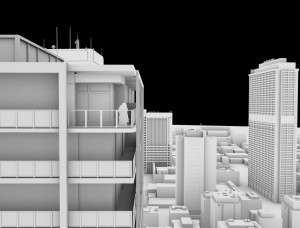
fxg: Is it true this key shot was brought up just one week before filming in Japan ? How much prep did you have?
LM: This shot was in and out several times during production as far as visual effects was concerned. I think they anticipated being able to shoot it in camera, yet due to complications, it eventually found it’s way to us – unfortunately with very little prep time. So yes, within a weeks notice, we were trying to walk them through ideas on how to approach the shoot, allowing optional methodologies in order to give them some options to begin their prep. Before I knew it, I received the call to board a plane to Tokyo to collaborate with Alejandro and Rodrigo, and collect all the data needed to complete the shot during a tight post schedule.
fxg: Where you involved with the second unit shoot with Masanobu Takayanagi?
LM: I had some second unit shooting, which involved further complicated logistical issues. Fortunately, we were able to scout a few locations which panned out to be exactly what we needed to shoot the footage necessary to complete the shot. Second unit also shot live action 360 degree plates of surrounding buildings in order to build a library of projection textures and moving matte painting elements. The entire second unit crew were very polished and an extremely tight unit by the time I arrived.
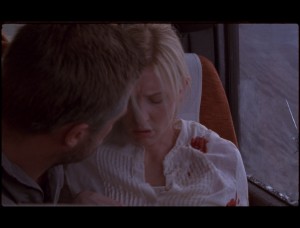
fxg: At various times in pre the production looked at 16mm , anamorphic, bleech bypass – and a range of looks, how did the final look of the film come together? I know the final grade was at Eclair Labs, but did the visual effects take into account the grading pipeline through Lustre?
LM: Our main challenge was how we were going to handle the various formats, with most attention on 16mm given that the grain was much larger, and paintwork could be much more noticeable. The other challenge which cropped up during the grading process was with the final Tokyo shot. This shot proved challenging only because the C/U was a specific look matching tighter shots Rodrigo had in the sequence (warm tones), whereas the exterior shots of Tokyo were more on the side of greens/blues.
As we pulled out of the C/U, we begin to reveal the background, and this couldn’t be warm, especially as we pull out to an extreme wide shot of Tokyo. Being warm on the balcony, and throughout the city would make the shot look completely out of place compared to other establishing shots of Tokyo in the sequence. With further collaboration between Rodrigo, the colourist and ourselves the problem was resolved with various mattes and colour corrections.
Take a look at some of Intelligent Creatures’ work on Babel, by downloading a QuickTime movie demo.
Raymond Gieringer onThe Fountain and Stranger Than Fiction
Stranger Than Fiction
This is an outstanding, intelligent and witty film.
“This is a story about a man named Harold Crick… and his wristwatch. Harold Crick was a man of infinite numbers, endless calculations and remarkably few words. And his wristwatch said even less.â€
— The Narrator
After ten years of painstaking work, novelist Karen Eiffel (Emma Thompson) is nearing completion on her latest and potentially finest book. Her only remaining challenge is to figure out how to kill off her main character, Harold Crick. Little does she know that Harold Crick (Will Ferrell) is inexplicably alive-and-well in the real world, and suddenly aware of her words. Fiction and reality collide when the bewildered and hilariously resistant Harold hears what she has in mind and realizes he must find a way to change her (and his) ending.
To achieve the out-of-the-ordinary experience of being Harold Crick, Ferrell traced the evolution of the feelings the character might undergo upon discovering that he is “being followed by a woman’s voice†– from comic shock to deep despair to a determination to try to change his fate. “I think, at the start, Harold is generally freaked out by the whole thing,†Ferrell has said. “He’s worried, upset and doesn’t know what to think, because he’s not sure if what’s happening to him is real or not. His reactions are typical of those most of us would have. The comedy comes from his attempts to maintain his composure so no one thinks he’s crazy.â€
On set, Ferrell was able to literally re-create the experience of having a voice in his head because Emma Thompson had pre-recorded her narration, which was then played to Ferrell through an ear-piece during his scenes. “Emma has such a great voice,†he remarks. “It was great fun to have her in my head, and also weird for all the right reasons.â€
Thompson easily sums up why she was attracted to the film. “It was the best script I’d read in years and years,” she states. “It was one of those rare instances where you think, ‘Yes, absolutely, I’ll do anything to serve this writing.’ The way in which Zach Helm created a fictional reality and a real fiction — going both ways at once — is one of the most remarkable things I’ve encountered. There’s nothing better than a combination of serious human inquiry and good gags.” “Emma said yes to the part on page 22,†according to the film’s director, Marc Forester (Monster’s Ball and Finding Neverland)
In one vital scene Ferrell is nearly killed in the demolition sequence. For this and other shots, Intelligent Creatures provided the effects. We discussed this and the Candian Cartel with Raymond Gieringer
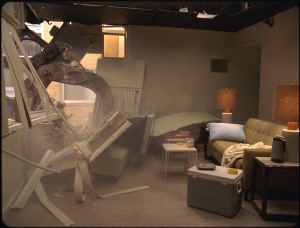
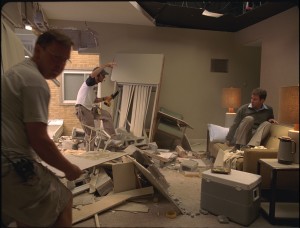
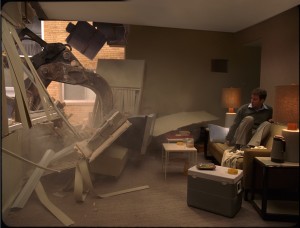
fxg: This is one of our favorite films of the year – just outstanding – intelligent film – when did you guys get involved ?
RG: We agree; it is a truly smart and touching film. We were brought on board just before they started principle photography. It was great to be on set in Chicago as they were filming, and to have input into the various shots and sequences that we would be working on.
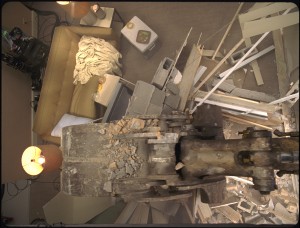
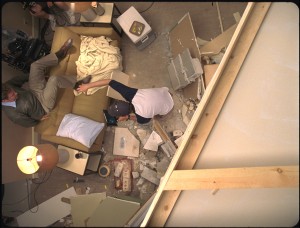
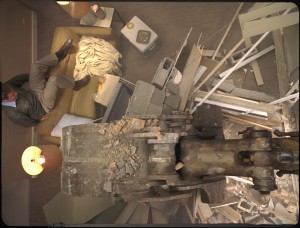
fxg: What was the nature of the shots you had to do on the film?
RG: We created exterior matte paintings and split-screen composites for the claw demolition scene. Within this sequence, a construction crew mistakenly starts demolishing Will’s apartment while he’s still in it. To sell it we combined plates with Will reacting to nothing with plates of the gag (the claw crashing through the wall) In the end, the audience can believe that Will was always in the room as the demolition was happening. Within this series of shots, we also composited insert footage of nature scenes into the television that Will is watching.
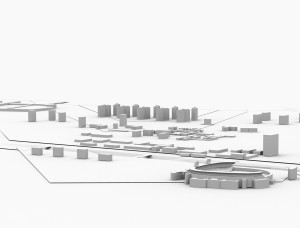
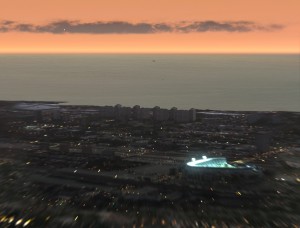
fxg: Given the schedule, how long did you have to work on the material? What was the post schedule?
RG: The two main sequences that we worked on were the Claw shots that I mentioned above, and the opening fly in from the moon’s point of view of the earth down to the wrist watch on Will Ferrell’s bedside table. The claw shots were finished within a five month time frame, but given the scope of the opening shot, we literally worked on it until just before the film went into limited (film festival) release…close to ten months.
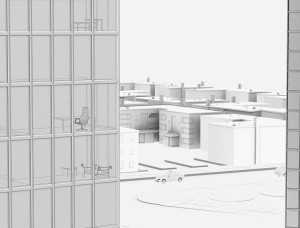
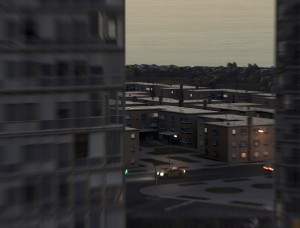
fxg: What was it like integrating with so many other effects companies, and can you discuss the Canadian Cartel ?
RG: We have worked in conjunction with other companies before, but in the case of “Strangerâ€, are sequences were quite modular, so we didn’t have any real interaction with the other FX houses. Before “Strangerâ€, we worked with the Canadian Cartel on another of Marc Forster’s films called “Stayâ€. They act as a production service for studios or “virtual VFX vendor†in that they gather and manage vendors under one umbrella to work on a show. Additionally, they help to represent individual or small groups of talented artists that can be overlooked for film work because they are not part of a larger company.
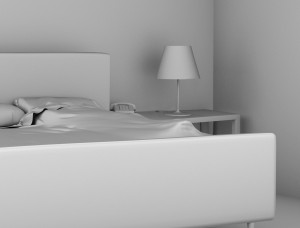
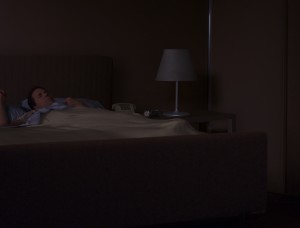
fxg: Kevin Tod Haug was the VFX sup is that correct?
RG: Kevin is a long time mentor and friend. He was the Visual Effects Designer on “Strangerâ€. He is also one of the co-founders of the Cartel.
The Fountain
The Fountain is not an easy film. Complex and spanning hundreds of years, it provides complex imagery to decode a complex story. The imagery is beautiful and arresting.
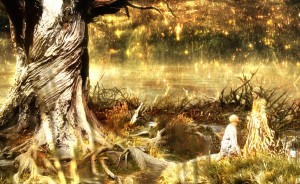 fxg: The fountain is visually remarkable, can you discuss how quickly you managed to develop the looks, or production design of the shots?
fxg: The fountain is visually remarkable, can you discuss how quickly you managed to develop the looks, or production design of the shots?
RG: We were privileged to be involved early in the research and development of the space environment, before principle photography began. Our initial design and tests had proven to everyone that the methodology for creating the space backgrounds using macro-photography footage would work. So by the time we were actually shooting our shots, we were able to quickly composite our initial backdrops into the scenes to test them. This proved invaluable to both Darren and Matty, the director of photography, in that they could have a better sense of placement and lighting on the set. And it also helped us early in the process to see what was and was not working.
fxg: InitiallyThe Fountain had a much larger budget, when the film had been planned for Sydney with Brad Pitt. Then Pitt had to pull out. Is it fair to say in some ways this worked for you as you needed to find new and innovative ways to express the creative vision of the script? Is it true Darren Aronofsky had a very clear vision of the imagery by the time you did start work?
RG: Darren was very clear from the beginning that he wanted the film to have a timeless feel. With respect to the visual effects, he was concerned that an all CG approach to the space environments might produce work that felt dated five years from now. So we decided to use practical macro-photography elements as the basis for our CG environments, rather than just building it all digitally. Since our mandate was to produce work that would stand up over time, we were determined to use, for the most part, real world elements as the basis for the much larger canvasses we would digitally assemble later.
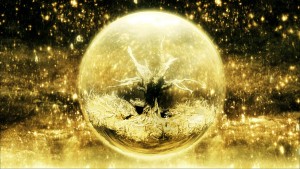 fxg: What was the pipeline for the effects shots? What were the stages or departments that the shots would move though?
fxg: What was the pipeline for the effects shots? What were the stages or departments that the shots would move though?
RG: The initial stage was to develop the various “Hero†backgrounds that we would need over the course of the space sequences. Several key compositors created the main environments that would show the evolution of the trek that Tom (Hugh Jackman) was undertaking. While we designed these backdrops, many more compositors were prepping the GS plates for later insertion of our environments.
At the same time, R&D was being done to determine the look of the CG bubble that would encompass the ship. Once the hero backgrounds and greenscreen keying were completed, the assembly of the shots began, utilizing both 2D and 3D final elements. The source plates were 10 bit logarithmic files, and we worked in float space so every bit of data in the original plate was maintained.
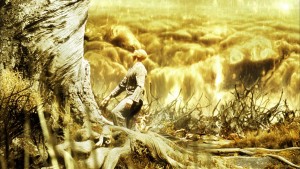 fxg: Were there any special considerations for the grade (DI)? The film has a very clear golden hue.
fxg: Were there any special considerations for the grade (DI)? The film has a very clear golden hue.
RG: The overall golden hue was a specific aesthetic that Darren had, so we definitely biased our shots to that end. There were however, shots towards the end of the sequence (when Hugh was very close to the dying star) that required a very specific color treatment. For these shots we worked directly with both Darren and Matty to establish the look before they did their final grading.
fxg: Were you involved with the tree of life shots/sets ?
RG: Our only involvement was with the leafless tree as it existed on the ship as Hugh travels towards the dying star. The full scale tree/ship stage was shot against GS, and we also utilized a miniature tree/ship model for some of the wider exterior shots.
